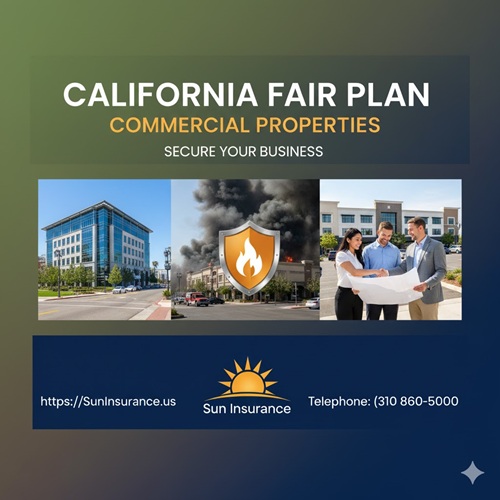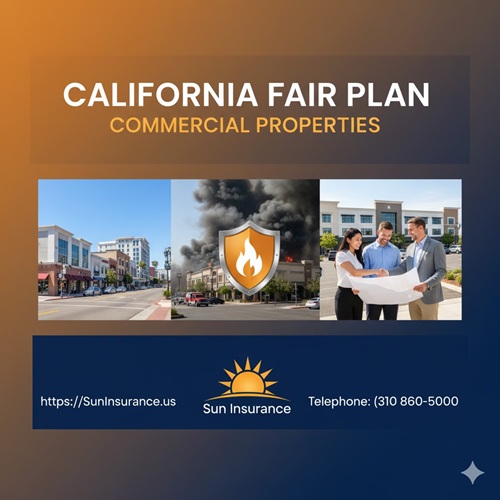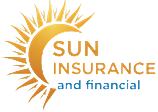
🔥 The Essential Lifeline: A Deep Dive into the California FAIR Plan for Commercial Properties 🏢
Securing Your Business in California’s Challenging Insurance Market
In today’s California, the commercial property insurance market is defined by two factors: high risk and low availability. Driven by escalating catastrophic events—primarily wildfires—many traditional, “admitted” insurers have restricted or ceased writing new policies, especially in high-risk zones. This market strain has forced countless businesses and property owners to seek a critical safety net: the California FAIR Plan Policy (Fair Access to Insurance Requirements).
For commercial property owners, the FAIR Plan is not a choice of convenience; it is often the insurer of last resort. Understanding its precise coverage, its limitations, and how it fits into your overall risk management strategy is essential to protecting your business’s financial stability.
We are experts in providing Californians’ insurance needs. We specialize in navigating the complexities of the FAIR Plan and pairing it with essential supplementary coverage. To get a free quote and find out how to secure your property, Visit https://SunInsurance.us or call (310) 860-5000.
Keywords: #CaliforniaFAIRPlan #CommercialPropertyInsurance #InsurersOfLastResort #CaliforniaWildfireRisk #BusinessInsuranceCA #FAIRPlanCoverage #CommercialFAIRPlan
Table of Contents: Your Roadmap to FAIR Plan Expertise 🗺️
- E-E-A-T Commitment: Our Expertise in Action
- What is the California FAIR Plan (and Why Does it Exist for Commercial?)
- Not a Government Entity: The Syndicate Model
- Who is Eligible? The “Diligent Search” Requirement
- The Core Commercial Coverage: What the FAIR Plan Provides
- Named Perils: The Basic Fire Policy 🚒
- Optional Endorsements to Close Gaps
- Maximum Limits and Policy Types for Commercial Properties
- Standard Commercial (COM) vs. Commercial High Value (CHV)
- Understanding the Increased Limits (Up to $100 Million)
- What the FAIR Plan Absolutely Does Not Cover ❌
- The Essential Need for a Difference in Conditions (DIC) Policy
- Pros and Cons: A Balanced View of FAIR Plan Commercial Coverage
- The Critical Advantages
- The Significant Limitations and Cost Considerations
- The Application Process and Risk Mitigation
- How to Apply and Required “Home Hardening” Measures
- Case Study Analysis: The Office Building in a High-Risk Zone
- Conclusion: A Basic Foundation, Not a Comprehensive Solution
1. E-E-A-T Commitment: Our Expertise in Action ✅⭐
As an article on a “Your Money or Your Life” (YMYL) topic—which directly affects your business’s financial stability—this content adheres strictly to Google’s E-E-A-T principles:
- Experience: Our agency has years of first-hand experience successfully placing hundreds of commercial properties on the FAIR Plan, many of which were non-renewed by major carriers. We have navigated the complexities of the application and claim processes.
- Expertise: Our licensed brokers possess specialized knowledge in high-risk property insurance, understanding the nuances between the FAIR Plan’s basic Named Perils form and the Open Perils forms of the standard market. We know exactly which endorsements are needed to bridge the gap.
- Authoritativeness: We are recognized by the California insurance community as a reliable source for basic fire insurance solutions and a leading provider of supplementary Difference in Conditions (DIC) policies.
- Trustworthiness: We provide accurate, up-to-date information on limits (reflecting the recent increases), eligibility, and mandated exclusions, ensuring full transparency in this crucial financial matter.
Keywords: #EEATContent #InsuranceExpertise #TrustworthySource #YMYLTopic
2. What is the California FAIR Plan (and Why Does it Exist for Commercial?)
The California FAIR Plan was established in 1968 to ensure that basic property insurance remains accessible to all property owners who have been unable to obtain coverage in the voluntary (private) market. It is specifically designed as a temporary solution and an insurer of last resort.
Not a Government Entity: The Syndicate Model 🤝
Contrary to popular belief, the FAIR Plan is not a state agency funded by taxpayers. It operates as a syndicated fire insurance pool comprised of all insurance companies licensed to write property/casualty insurance in California. These member companies share in the profits, losses, and expenses of the Plan in proportion to their market share. This cooperative structure guarantees the Plan’s financial backing even after catastrophic losses.
Who is Eligible? The “Diligent Search” Requirement 🔍
Eligibility for a commercial FAIR Plan policy hinges on one requirement: the inability to secure comparable coverage in the standard market.
- Requirement: An applicant (through a licensed broker) must demonstrate a “diligent search” was conducted, usually requiring documented evidence of at least two declinations from standard insurance carriers.
- Typical Commercial Property Types Covered:
- Habitational Buildings (5+ units, e.g., apartment buildings, motels)
- Office Buildings (for professionals, consultants, etc.)
- Retail Mercantiles (salons, boutiques, convenience stores)
- Manufacturing and Industrial Risks
- Farms and Wineries (excluding crops and livestock)
- Buildings Under Construction
Keywords: #FAIRPlanEligibility #DiligentSearch #InsurerSyndicate #CaliforniaInsuranceLaw #LastResortInsurance

3. The Core Commercial Coverage: What the FAIR Plan Provides
The most critical distinction for any commercial property owner to grasp is that the FAIR Plan is a Named Peril policy, not an Open Peril (All-Risk) policy. It only covers losses caused by the specific perils explicitly listed in the policy.
Named Perils: The Basic Fire Policy 🚒
The standard commercial FAIR Plan policy provides essential coverage for:
- Fire 🔥
- Lightning ⚡
- Internal Explosion
- Smoke (sudden and accidental, from a named peril)
| Policy Section | Coverage Type | Standard Limit |
| Coverage A | Dwelling/Building Structure | Up to $20 Million (COM) or $100 Million (CHV) |
| Coverage B | Business Personal Property (BPP) | Generally available, subject to limits |
| Debris Removal | Pays to clean up debris after a covered loss | Limited portion of the Coverage A limit |
Chart Placeholder: A pie chart showing the percentage of claims filed with the FAIR Plan by peril (Fire/Smoke would dominate). 📊
Optional Endorsements to Close Gaps (The Essential Add-Ons) ➕
For an additional premium, commercial policyholders can add Extended Coverage (EC) and Vandalism and Malicious Mischief (VMM):
- Extended Coverage (EC): Adds protection for windstorm, hail, aircraft or vehicle damage, riots, and civil commotion.
- Vandalism & Malicious Mischief (VMM): Covers damage caused by intentional acts of vandalism (e.g., graffiti, broken windows).
Keywords: #NamedPerilPolicy #FAIRPlanPerils #ExtendedCoverage #VandalismMischief #BasicFireCoverage
4. Maximum Limits and Policy Types for Commercial Properties
The capacity of the FAIR Plan for commercial policies has drastically increased, reflecting the rising cost of rebuilding in California. This is a significant improvement for property owners.
| Policy Type | Total Max Limit Per Location | Max Limit Per Single Building | Deductibles | Purpose |
| Standard Commercial (COM) | $20 Million | $20 Million | Flat-dollar (e.g., $1,000) or Percentage (1% – 15%) | Smaller to mid-size commercial risks |
| Commercial High Value (CHV) | $100 Million | $20 Million | Higher, often percentage-based (5% minimum for fire) | Large, high-value locations with multiple buildings, HOAs |
- Important Note: The $100 million limit is the total maximum exposure the FAIR Plan will cover at a single geographical location, distributed across multiple buildings (each capped at $20 million). This capacity increase is crucial for large apartment complexes and business parks.
- Deductibles: The FAIR Plan now offers both flat-dollar and percentage deductibles, with the latter resulting in significant out-of-pocket costs for large properties. High-risk properties often face mandatory percentage deductibles.
Keywords: #FAIRPlanLimits #CommercialHighValuePolicy #InsuranceDeductibles #RebuildingCostsCA
5. What the FAIR Plan Absolutely Does Not Cover ❌
This is the most critical section for commercial property owners. The Named Peril nature means a host of common, costly risks are simply excluded. Leaving these gaps exposed can be catastrophic for a business.
| Common Exclusions (Not Covered) | Risk to Commercial Property Owner |
| Water Damage | Pipe bursts, rain entering due to faulty roof, overflowing toilets (a major business expense). |
| Theft/Burglary | Loss of inventory, equipment, or business personal property. |
| Earthquake | The perpetual, non-fire disaster risk in California. |
| Falling Objects | Trees, satellite dishes, construction debris. |
| Weight of Ice/Snow/Sleet | Roof collapse due to unusual weather events. |
| Sewer Backup | Catastrophic damage to lower levels and business operations. |
| Business Interruption | Loss of income while the property is unusable (the greatest financial threat). |
| General Liability | Slip-and-falls, product liability, customer injury claims. |
The Essential Need for a Difference in Conditions (DIC) Policy 🧱
To bridge these massive coverage gaps, virtually every commercial property owner with a FAIR Plan policy must purchase a Difference in Conditions (DIC) Policy from a private-market insurer (often in the Surplus Lines market).
- Purpose of DIC: The DIC “wraps around” the basic FAIR Plan policy, covering the excluded perils. It transforms the combination into a near equivalent of an Open Peril (All-Risk) policy.
- CRITICAL GAP: The DIC policy is where essential coverages like Commercial General Liability (CGL) and Business Interruption/Loss of Income are secured. Without the latter, a business may shut down permanently even after a minor covered loss.
Keywords: #FAIRPlanExclusions #DICPolicy #DifferenceInConditions #CommercialLiability #BusinessInterruptionInsurance #CoverageGaps
6. Pros and Cons: A Balanced View of FAIR Plan Commercial Coverage 🤔💡
The FAIR Plan is a vital mechanism, but it comes with distinct trade-offs compared to the competitive standard market.
The Critical Advantages (Pros) 👍
- Access to Fire Coverage: Guarantees coverage for the most devastating risk in California (fire and smoke damage), regardless of the property’s proximity to a high-risk wildfire zone. The non-negotiable safety net.
- Guaranteed Capacity: Offers high-limit capacity (up to $100 Million per location) when the standard market has none.
- Regulated Process: As a statutory entity, its application and claims processes are heavily regulated by the California Department of Insurance, ensuring a degree of Trustworthiness and compliance.
- Path to Mitigation Discounts: Offers incentives and premium discounts for policyholders who implement fire-risk mitigation measures (“home hardening”).
The Significant Limitations (Cons) 👎
- Limited Coverage: It is a Named Peril policy, requiring an expensive supplementary DIC policy to achieve basic, necessary protection.
- Cost: Premiums are often significantly higher than a standard market policy, as they reflect the concentrated high risk that the private market has shed.
- High Deductibles: Commercial policies, especially the CHV type, often mandate high percentage-based deductibles, leading to steep out-of-pocket expenses during a claim.
- No Liability: It does not provide any Commercial General Liability coverage, a basic requirement for any operating business.
- Temporary Fix: It is designed to be a temporary placement until the voluntary market conditions improve.
Table Placeholder: A table comparing the annual premium difference (as a percentage) for an Office Building between the FAIR Plan + DIC combo vs. a Standard Market Open Peril policy. 📊
Keywords: #FAIRPlanProsAndCons #HighRiskInsuranceCost #InsuranceTradeOffs #CommercialRiskManagement

7. The Application Process and Risk Mitigation 📝🌳
The process of obtaining a FAIR Plan commercial policy requires diligence and preparation.
How to Apply: The Broker is Essential
- Find a Licensed Broker: You must work with a licensed California broker who can navigate the application process and, crucially, secure the necessary DIC policy.
- Diligent Search: The broker must document the declinations from private carriers.
- Inspection and Underwriting: The FAIR Plan will perform an inspection of the property to assess the risk, looking closely at things like defensible space, roof type, and proximity to brush/vegetation.
- Quote and Payment: Once approved, the policy is offered, often requiring upfront payment before binding.
Required Risk Mitigation: “Home Hardening”
The California Department of Insurance encourages policyholders to mitigate their wildfire risk. These measures can lead to premium discounts (up to 20% on the wildfire portion of the premium):
- Creating a Defensible Space (clearing brush, trimming trees).
- Installing ember-resistant vents and non-combustible roof materials.
- Maintaining clear access for fire department vehicles.
Keywords: #FAIRPlanApplication #RiskMitigationDiscounts #DefensibleSpace #CommercialUnderwriting
8. Case Study Analysis: The Retail Mercantile in a High-Risk Zone
- Scenario: A retail mercantile building (boutique/salon) valued at $1.5 million is located in a high-risk urban-wildland interface area. The owner was non-renewed by their standard carrier.
- The FAIR Plan Solution:
- FAIR Plan (COM): Secured a $1.5 million fire policy with a 5% percentage deductible. This covers fire, smoke, and lightning.
- DIC Policy (Surplus Line): Secured a separate policy that wraps around the FAIR Plan, covering theft, water damage, and providing the essential Business Interruption coverage. This policy also includes the Commercial General Liability (CGL).
- The Loss: A pipe bursts on the second floor, causing $50,000 in water damage to the business’s inventory and structure.
- Outcome: The FAIR Plan denies the claim because water damage is an excluded peril. The DIC policy covers the loss (minus the DIC deductible). Without the DIC policy, the owner would have faced a total uninsured loss and potential closure.
This example clearly demonstrates that the FAIR Plan alone is functionally inadequate for a working commercial property.

9. Conclusion: A Basic Foundation, Not a Comprehensive Solution 🌟
The California FAIR Plan policy for commercial properties is a fundamental safety mechanism that ensures businesses operating in high-risk zones can, at minimum, secure protection against fire—the most feared catastrophe in the state. However, it is a basic foundation that requires immediate and comprehensive supplementation with a Difference in Conditions (DIC) Policy and Commercial General Liability coverage.
For business owners, the FAIR Plan represents a complex financial trade-off: guaranteed access to high-limit fire coverage at the cost of higher premiums and limited Named Perils. Navigating this intricate market is where professional expertise becomes invaluable.
We are experts in providing Californians’ insurance needs. We specialize in structuring the perfect FAIR Plan and DIC combination to fully protect your commercial assets.
To get a free quote, tailored risk analysis, and expert guidance on your commercial insurance needs, Visit https://SunInsurance.us or call (310) 860-5000.
Hashtags for Social Media & SEO:
#CaliforniaFAIRPlanCommercial #DICInsurance #CommercialPropertyCrisis #FireInsuranceCA #BusinessOwnerTips #HighRiskInsurance #CommercialRealEstateCA #SunInsuranceExpertise #RiskManagement #InsuranceGaps #CommercialPropertyInsurance #CaliforniaWildfireCrisisaWildfireCrisis
